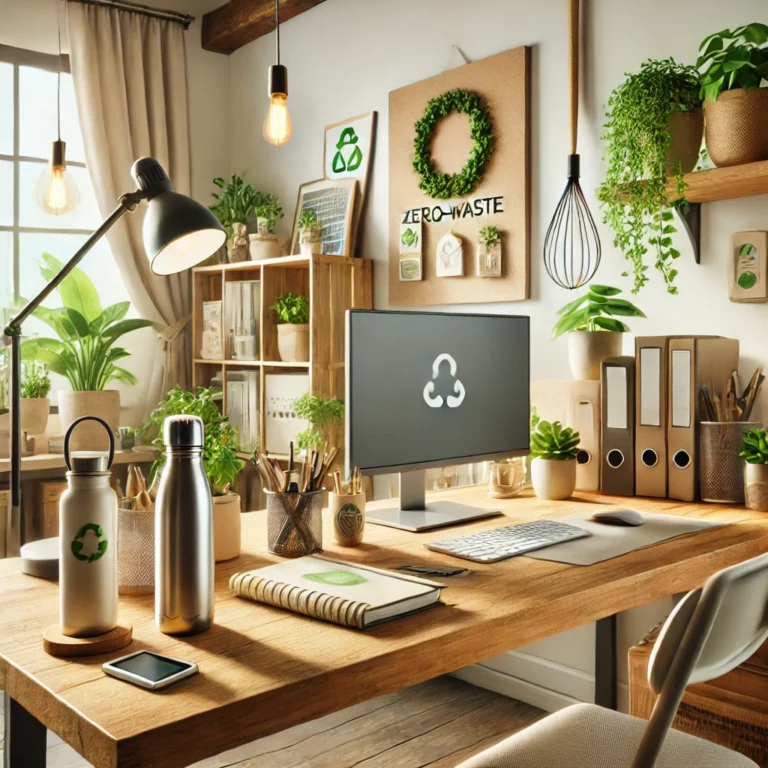Physical Address
304 North Cardinal St.
Dorchester Center, MA 02124
Physical Address
304 North Cardinal St.
Dorchester Center, MA 02124


Ever wondered how you could make your workspace greener and reduce waste? Setting up a zero-waste office at home is simpler than you think! With a few practical changes, you can turn your home office into a space that aligns with your sustainable values. Let’s explore how you can create an eco-friendly workspace that’s kind to the planet and your productivity.
With remote work becoming a global norm, home offices have grown in importance, making it the perfect time to rethink our workspaces. Traditional offices can produce significant waste, from paper and packaging to discarded supplies. By adopting a zero-waste approach, you not only minimize waste but also create a workspace that’s healthier, more organized, and more environmentally friendly.
The Environmental Protection Agency (EPA) estimates that nearly 80% of office waste is recyclable, yet a large portion still ends up in landfills. A zero-waste office reduces your carbon footprint and inspires others to adopt similar eco-friendly practices.
Ready to transform your home office into a zero-waste zone? Here are some globally applicable tips to help you reduce waste and create a sustainable workspace.
Start by selecting supplies that are either reusable, recyclable, or made from eco-friendly materials. Look for pens made from recycled plastic, refillable ink cartridges, or notebooks made from recycled paper. These small changes can make a big difference over time.
Sarah, a graphic designer in London, switched to refillable pens and recycled notebooks. She noticed not only a reduction in waste but also an improvement in her workspace’s organization, as she only bought supplies she truly needed.
Explore recycling programs for office supplies through Terracycle to help you dispose of supplies responsibly.
Going paperless is one of the easiest ways to reduce office waste. Use digital tools for note-taking, project management, and communication. Tools like Google Docs, Trello, and Asana help keep projects organized without the need for paper. For essential documents, consider using a digital signature service.
In Germany, Markus decided to ditch his printer and switched to entirely digital note-taking. Over the course of a year, he saved hundreds of sheets of paper and found it easier to organize his notes on his laptop.
If paper or packaging waste is unavoidable, set up a simple recycling station in your office. This could be as easy as placing a small recycling bin next to your desk. Be sure to separate waste types if needed and clean containers before recycling them.
Find local recycling options with Earth911’s recycling locator, which can help you identify where to recycle different types of materials.
Reducing energy consumption is an important part of a zero-waste office. Switch off lights and devices when not in use, and consider using energy-efficient lighting. If you’re in an area with solar power options, think about investing in a solar-powered charger for smaller devices.
Claire from Sydney installed LED lights in her home office and noticed a significant decrease in her monthly electricity bill. She also started turning off her computer monitor when stepping away for more than a few minutes, cutting down on energy use effortlessly.
Furnishing your home office with sustainable, durable items can help reduce waste over time. Look for furniture made from reclaimed or FSC-certified wood, or consider upcycling old furniture. Decor items like plants not only brighten the space but also improve air quality, making your office feel fresh and inviting.
In New York, Tom found a second-hand wooden desk that fit his home office perfectly. Not only did he avoid buying new, but he also saved money and gave new life to a beautiful piece of furniture.
Jessica, a writer based in Brazil, transformed her home office into a zero-waste zone over a period of six months. She switched to digital planning, opted for eco-friendly supplies, and set up a small recycling station in her workspace. Not only did she reduce her environmental impact, but her workspace became more organized and inviting. Inspired by her success, she even shared her tips with her co-workers, sparking a mini eco-movement in her team!
Have you tried any of these zero-waste office tips? Creating an eco-friendly workspace doesn’t have to be overwhelming. By taking small steps, you can reduce waste, save money, and enjoy a cleaner, greener office.
What’s your favorite tip for creating a sustainable workspace? Share your thoughts with us, and let’s inspire each other to build a zero-waste world—one office at a time!